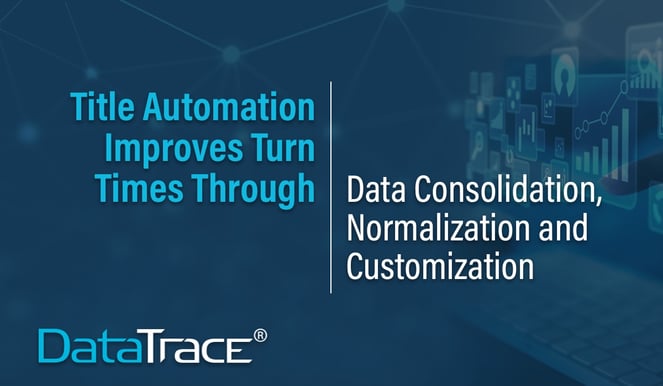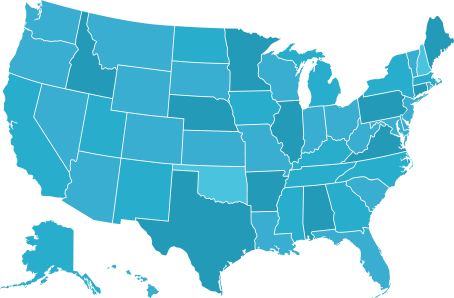
— As the industry becomes more digitized, title automation increasingly helps businesses reduce operational costs, create more efficiencies, and improve production processes to optimize their day-to-day operations. —
As title automation continues to evolve, one of the ways it achieves greater efficiencies is by simplifying production workflows. Often this takes the form of incremental enhancements that address prominent business challenges tailored to preferred speeds of company adoption.
While there is no question that the rise of title automation can generate streamlined, more accurate and faster operational results – and will play an increasingly important role in the future of our industry – not all businesses are ready or able to fully embrace this technology.
Standardizing data for rapid results
While smaller markets still exist where digital records are not available, or limited, and still require a more traditional online or manual search solution, business leaders are employing automation to maximize their potential in larger areas. However, outside of these smaller counties, title automation is available for most major markets and DataTrace® provides automation on nearly half of the U.S. population. One approach our clients are doing today, if they are still not ready to shift fully to automation, is to start with a scaled portion of their business. For example, clients can elect to automate refinance and less complex purchase transactions – while maintaining their traditional search procedures for more complicated deals.
Accommodating these realities usually meant maintaining multiple workflows that generated reports, documents, and images in different formats. The results from search automation often look and feel different than what an abstractor might deliver or what’s generated from online results since the formatting isn’t consistent.
To address this challenge, search automation technology providers are working to enhance their solutions to enable the collection and normalization of multiple results from various sources that a title company might use, similar to our TitleIQ™ solution. The final product is a single, standardized data title search report which can deliver a more complete package in under ten minutes.
Using technology to enhance technology
Technology not only improves current operations and performance but can also unlock value between systems – as long as the two technologies communicate. OCR has changed the way in which many industries conduct business, and that’s certainly the case in the title industry. No matter how advanced OCR gets, minor issues remain, particularly with old analog documents that have handwritten elements or low-resolution quality.
As a result, examiners must spend time correcting minor clerical errors – not the most efficient use of their time. To address this issue, search automation technology providers are working to offer an enhanced review of their title results to flag these minor issues before examination and educate the machine learning technology to further enhance OCR results. For instance, if a historical document is corrected to accommodate the way people wrote many years ago, that learning should be carried through and recognized in future document reviews, thereby increasing even more OCR efficiencies.
Customization is key in automation
Offering the ability to customize title automation is a valuable – and needed – option for many clients. Beyond customization, searches should be based on the client’s business rules and additional data sources so that analysis can be incorporated and customized to fit specified parameters, further improving the efficiency and cost-effectiveness of data deliverables. For some clients, customization to meet their product guidelines is important, and for others, being able to customize based on changing external market conditions is top priority.
One client may want to use their network of abstractors in all 3,300 counties; another client may want to only use abstractors in select counties based on geography or product type; and still another client may not use abstractors at all. Whatever the reason or approach, having the flexibility to pivot and customize, particularly as clients continue the automation migration, is key.
To further improve automation efficiencies and accommodate clients at various intervals of the automation journey, providers should have a consolidated onboarding process to enable clients to easily move from simple search automation to a more comprehensive solution that includes examination, while only being onboarded once. These more comprehensive solutions hopefully deliver full, end-to-end automated title reports plus examination, leveraging nationwide data resources, unified title search workflows, a robust examination workbench and direct title production integration – such as TitleIQ Enterprise does. Being able to onboard at an entry level with the capacity to shift to more robust search and examination takes the pressure off companies as they navigate what, when and how to adopt title automation.
As the industry becomes more digitized, title automation increasingly helps businesses reduce operational costs, create more efficiencies, and improve production processes to optimize their day-to-day operations. DataTrace is committed to being the catalyst to help title companies accelerate their adoption of intelligent automation solutions in all markets.
Click here to learn more about you can improve your turn times by up to 50% while reducing errors with TitleIQ Search Automation and TitleIQ Enterprise.
 Geographic Coverage
Geographic Coverage





